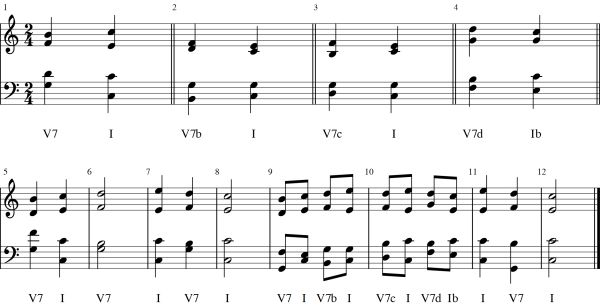Audio: dominant seventh (0:12)

dominant seventh plays dominant seventh chords and tonic triads on a harmonium in the key of C. The dominant seventh figure shows the score:
A dominant seventh is a tertian chord with four different notes.
The dominant seventh is constructed by adding another third on top of a major triad. It consists of a root, major third, perfect fifth and minor seventh.
Functional harmony in four parts uses a dominant seventh chord as well as a triad. A dominant seventh chord is not a triad, a triad has three notes that differ, a dominant seventh has four notes that differ.
The dominant seventh is so named, not because it is domineering, but because it is usually constructed on the dominant, the fifth degree of the scale, V7. There is only one dominant seventh chord that contains diatonic notes, notes that are part of the scale, and it is the V7. For example, in the key of C the V7 chord is GBDF, and all the notes are diatonic. The V7 is absolutely diagnostic of a key, which is the reason the chord is used, to promote tonality.
The function of the dominant seventh V7 remains that of the underlying triad V. The dominant seventh leads to the tonic, V7-I or V7-i, in exactly the same way as the triad on the dominant leads to the tonic, V-I or V-i. Extending the dominant triad to make a dominant seventh changes the quality of the chord but not its function.
The dominant seventh is a dissonant chord. It contains two dissonant intervals, a minor seventh above the root, and a tritone between the third and seventh. These two dissonances cannot be avoided by inversion. Inverting a minor seventh produces another dissonance, the major second. Inverting a tritone simply produces another tritone. Consequently, it does not matter whether the chord is voiced in root position, as in the first bar of dominant seventh, or first inversion, as in bar 2, second inversion, as in bar 3, or third inversion, as in bar 4, because, no matter which of the four notes is put in the bass, there will always be at least one dissonant interval between the bass part and the upper SAT voices.
In functional harmony, a dissonant chord must always resolve to a consonant chord. Two dominant sevenths cannot follow in succession to create two dissonances, which is why there are no parallel seconds or sevenths in functional harmony. A dissonant dominant seventh must always resolve to a consonant major or minor triad.
Voice leading a dominant seventh requires some thought. The usual approach is to resolve the dissonances first, starting with the tritone. Using the V7-I progression G7-C as an example, the tritone resolves by step either inwardly to a third, BF-CE, or outwardly to a sixth, FB-EC. The leading note of the scale, B, is part of the tritone and in both cases resolves by step up to the tonic C. The second dissonance, the minor seventh, usually resolves down to a sixth not up to an octave, GF-GE rather than GF-GG. Putting these two resolutions together results in GBF-GCE or GFB-GEC. The C triad is in second inversion and needs to be in root position or first inversion with C or E in the bass and the D in V7 must lead to it. So the result is either DGBF-CGCE, V7c-I, or DGBF-EGCE, V7c-Ib.
You can, for fun, work out all the other possible permutations, but let us just mention one more point: voice leading root position chords, V7-I, generally requires one of the chords to be incomplete. Either an incomplete I, GBDF-CCCE, or an incomplete V7, GFGB-CEGC, does the trick. Two complete chords can, however, resolve if the leading note is in an inner voice and moves down by a leap of a third, GBFD-CGEC or GDBF-CCGE, for example.
One very interesting feature of the dominant seventh is that it contains a diminished triad. That is why the diminished triad, viio, is often treated as an incomplete dominant seventh, V7, in functional harmony. In other words, the viio is a V7 with a silent root. This enables root movement from the leading note to the tonic to be treated functionally as either viiob-I, root movement up a step, or V7-I, root movement down by fifth. Prior to the arrival of the dominant seventh, the consonant major and minor triads were floating up there with the angels and the dissonant diminished triad was down there in the primordial swamp, an undifferentiated blob, rarely mentioned in polite company, and only taken out on a tight leash after dark so as not to frighten the neighbours. The blob has now evolved into the dominant seventh and become respectable.